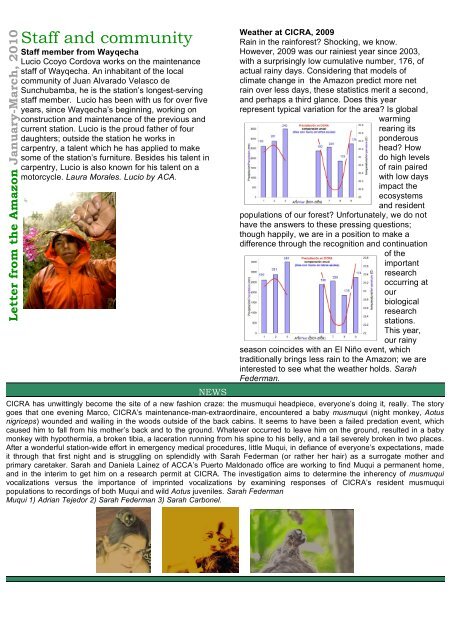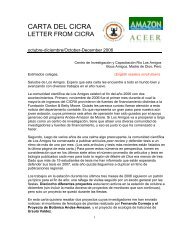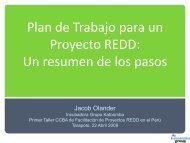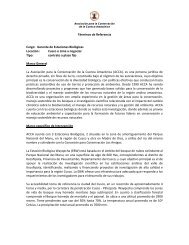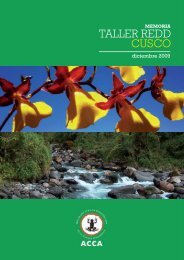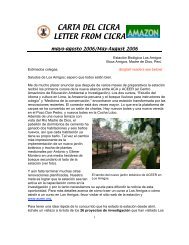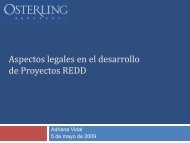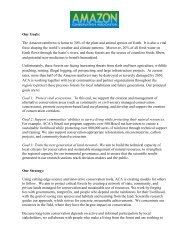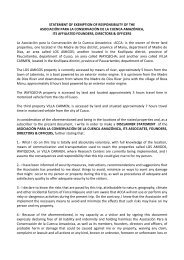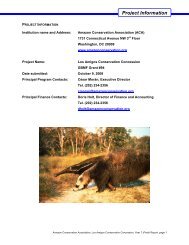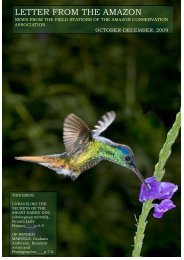LETTER FROM THE AMAZON - Amazon Conservation Association
LETTER FROM THE AMAZON - Amazon Conservation Association
LETTER FROM THE AMAZON - Amazon Conservation Association
You also want an ePaper? Increase the reach of your titles
YUMPU automatically turns print PDFs into web optimized ePapers that Google loves.
Letter from the <strong>Amazon</strong> January-March, 2010<br />
Staff and community<br />
Staff member from Wayqecha<br />
Lucio Ccoyo Cordova works on the maintenance<br />
staff of Wayqecha. An inhabitant of the local<br />
community of Juan Alvarado Velasco de<br />
Sunchubamba, he is the station’s longest-serving<br />
staff member. Lucio has been with us for over five<br />
years, since Wayqecha’s beginning, working on<br />
construction and maintenance of the previous and<br />
current station. Lucio is the proud father of four<br />
daughters; outside the station he works in<br />
carpentry, a talent which he has applied to make<br />
some of the station’s furniture. Besides his talent in<br />
carpentry, Lucio is also known for his talent on a<br />
motorcycle. Laura Morales. Lucio by ACA.<br />
Weather at CICRA, 2009<br />
Rain in the rainforest? Shocking, we know.<br />
However, 2009 was our rainiest year since 2003,<br />
with a surprisingly low cumulative number, 176, of<br />
actual rainy days. Considering that models of<br />
climate change in the <strong>Amazon</strong> predict more net<br />
rain over less days, these statistics merit a second,<br />
and perhaps a third glance. Does this year<br />
represent typical variation for the area? Is global<br />
warming<br />
rearing its<br />
ponderous<br />
head? How<br />
do high levels<br />
of rain paired<br />
with low days<br />
impact the<br />
ecosystems<br />
and resident<br />
populations of our forest? Unfortunately, we do not<br />
have the answers to these pressing questions;<br />
though happily, we are in a position to make a<br />
difference through the recognition and continuation<br />
of the<br />
important<br />
research<br />
occurring at<br />
our<br />
biological<br />
research<br />
stations.<br />
This year,<br />
our rainy<br />
season coincides with an El Niño event, which<br />
traditionally brings less rain to the <strong>Amazon</strong>; we are<br />
interested to see what the weather holds. Sarah<br />
Federman.<br />
NEWS<br />
CICRA has unwittingly become the site of a new fashion craze: the musmuqui headpiece, everyone’s doing it, really. The story<br />
goes that one evening Marco, CICRA’s maintenance-man-extraordinaire, encountered a baby musmuqui (night monkey, Aotus<br />
nigriceps) wounded and wailing in the woods outside of the back cabins. It seems to have been a failed predation event, which<br />
caused him to fall from his mother’s back and to the ground. Whatever occurred to leave him on the ground, resulted in a baby<br />
monkey with hypothermia, a broken tibia, a laceration running from his spine to his belly, and a tail severely broken in two places.<br />
After a wonderful station-wide effort in emergency medical procedures, little Muqui, in defiance of everyone’s expectations, made<br />
it through that first night and is struggling on splendidly with Sarah Federman (or rather her hair) as a surrogate mother and<br />
primary caretaker. Sarah and Daniela Lainez of ACCA’s Puerto Maldonado office are working to find Muqui a permanent home,<br />
and in the interim to get him on a research permit at CICRA. The investigation aims to determine the inherency of musmuqui<br />
vocalizations versus the importance of imprinted vocalizations by examining responses of CICRA’s resident musmuqui<br />
populations to recordings of both Muqui and wild Aotus juveniles. Sarah Federman<br />
Muqui 1) Adrian Tejedor 2) Sarah Federman 3) Sarah Carbonel.<br />
8


